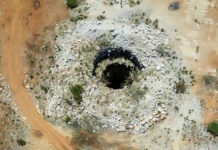
[miningmx.com] — GOLD FIELDS has effectively wrapped up control of South Deep, but anyone expecting immediate and dramatic changes in the way this unhappy gold mining project has been run is likely to be disappointed.
Within the past few weeks, Gold Fields has completed the acquisition of 50% of South Deep from Barrick and also completed the acquisition of the shares in Western Areas, owner of the other 50%, held by JCI (16.7%) and Harmony (29.6%).
Together with the 18% it already held in Western Areas, this gives it 65% of Western Areas, and it has an option over JCI on another 8.7%.
Gold Fields CEO Ian Cockerill said acceptances from minority Western Areas shareholders to the 35 Gold Field shares for 100 Western Areas shares tender offer are coming in steadily. The latest news is that Gold Fields owns 75.8% of the capital of Western Areas and that the tender will close at noon on December 29. The company is confident of garnering more shares now that the tender date is confirmed.
As a result, Gold Fields is close to being able to take out the remaining minorities compulsorily; and once it’s in that position, there’s little point in delaying matters.
Existing JV structure maintained
But though Gold Fields now has a significant economic interest in South Deep, Cockerill stresses that as long as there are any minority shareholders in Western Areas, the existing joint venture structure will be maintained.
He says Gold Fields won’t seek to put nominees on the Western Areas board until the tender closes, and even then it’ll probably be only one or two, leaving a majority of independent directors.
This attitude will no doubt change when there are no longer any minorities and Western Areas becomes a wholly-owned subsidiary of Gold Fields. This in turn will make South Deep wholly-owned, but even then Cockerill has played down the likelihood of major changes in the mine management.
“We’re happy with the team, though we may want to add to it, and in fact have already seconded a couple of people there on a temporary basis,” he insisted. “We’ll build the team as we get to understand the challenges and opportunities, supplementing it as necessary.”
Two masters bad for business
To suggestions that the troubled history of South Deep’s development to date doesn’t exactly reflect well on the current management, he responds that this may well have been more a reflection of the problems of operating with two masters under the joint venture structure, which hampered efficient decision-making.
Well, that’s a maybe, and the last thing Gold Fields would want is to disrupt management while there are still minority shareholders to be considered.
Perhaps bearing in mind the historic links between Western Areas/South Deep and the Kebble stable, Cockerill went out of his way during our conversation to stress the importance of adhering to sound corporate governance principles.
But what happens when there are no more minorities to consider remains to be seen. And the projected life of South Deep is such that there is bound to be some natural attrition of personnel, so the management will naturally take on more of a Gold Fields flavour over time.
As Cockerill said, phase one of South Deep is a 40-year project, and it will take at least six years to build up to the target output of 800,000 oz gold. The original intention, logically enough, was to follow phase one with phase two; but over the next 12 months, Gold Fields will be looking carefully at whether this can be accelerated.
Cockerill says there are a number of options to bring phase two forward, a key factor being the ability to get earlier access through Kloof. If phase two can be accelerated by 15-20 years, the impact on South Deep’s present value will be huge.
And overall, Cockerill is adamant he’s got a good buy. He says the purchase cost is equivalent to $100/oz, and at full output, production costs should be $300. This, he says, is not out of line with some recent deals in North America – where mining conditions and the life of deposits are far more problematic.
All this, he reckons, more than justifies any short-term dilution of Gold Fields’ earnings.
What about Harmony?
Meanwhile, what of Harmony? Once again, Gold Fields has stymied Bernard Swanepoel’s ambitions. But when Swanepoel made his foray on Gold Fields, he said the worst-case scenario was that it would in effect be a rights issue on attractive terms.
Much the same is true again, even if Harmony’s announcement that it is tendering its Western Areas shares puts the most favourable gloss possible on it.
Harmony says it paid R44.23 for its Western Areas shares, but as Western Areas was an associate they were carried in its books at estimated fair value, which was R40.61 at the time of disposal. So with the proceeds of R47.08 a share, it claims a surplus of R6.47.
Once again it’s lies, damned lies and accounting conventions. The true surplus is really only R2.85. And at Gold Fields’ latest R128.88, Western Areas is worth only R45.11, trimming the surplus yet further.
Even so, that’s still a premium to cost, whereas if Harmony wanted to raise the equivalent sum of about R2bn in a rights issue, it would have to issue shares at a discount. So even if Swanepoel didn’t get his first prize, he’s not going to come out of it too badly.











